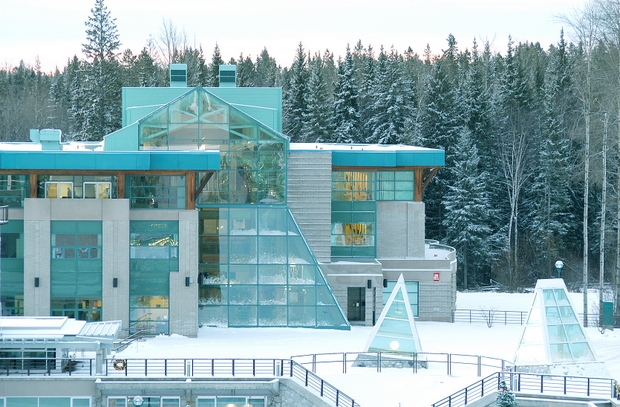Bumped Up A Notch: Maclean’s Ranks UNBC #2

UNBC’s Administrative Building photo courtesy UNBC
Prince George, BC – After four years in third spot, the University of Northern BC has been ranked number-two in the country in small, primarily undergrad universities in Maclean’s Magazine’s annual ranking – tying its highest ranking ever.
The 2012 ranking also marks the eighth straight year UNBC has been ranked the best university in its category among all facilities west of Atlantic Canada.
Maclean’s is citing UNBC’s second place finish as a huge accomplishment for the ‘young’ university, given the top university, Mt. Allison, is more than 150-years older. "UNBC, an 18-year-old school, debuted in 9th place 14 years ago. This year it has the highest total research dollars, and the second best student-faculty ratio – impressive for such a young school."
UNBC President George Iwama says, "All those associated with UNBC should take pride in their university."
"We have terrific faculty, fantastic students, great relationships with communities throughout the North, and a wonderful environment for teacher and research," he adds, "It’s no wonder UNBC continues to perform well in Maclean’s."

Comments
This is a GREAT news story and something I’m very proud of in our City.
Agreed. Good news.
We like the way Maclean’s ranks UNBC. We don’t like the way they rank us in crime.
The ranking is based on the amount of research dollars received, and the student to faculty ratio.
I think this means the less people in the classes the more points you get. Not sure how this works, if the reason you have less students is because you have declining enrolments.
Perhaps someone could elucidate.
Even if the reason for small class sizes is declining enrolment rather than wisdom in allocation of resources, the students still benefit from it, so it is a reasonable factor to consider in ranking universities.
Yes Palupo, once again NOTHING EVER GOOD happens in PG right…
sigh
Congrats UNBC!
Good point billposer. Your right, if its based on student benefits, regardless of cost per student.
Interceptor. I merely mentioned the fact that UNBC has had a declining enrolment for the past 5 years. In addition they are looking at a reduction in funding from the Provincial Government for the next 2 years at least. In addition they have been overfunded for the past five years, because their forcasts for student enrolments (which are the basis for funding) were over estimated.
So there are some problems at UNBC.
What is your solution to increasing the enrolment old wise one. Or would you prefer to carry on thinking that all is well on the hill???
“Perhaps someone could elucidate”
I took economics 101 as my elective in my first year at U of T. There was a class of somewhere between 400 and 500 students who assembled for their lectures at the theatre in the ROM (Royal Ontario Museum) on University Avenue. In those days there were no large monitors placed along the sides of a lecture theatre like that or monitors hanging from the ceiling.
So, we did not know whether the prof had shaven that day or not. In fact, sometimes we could not even hear the prof. And it was precisely that, a lecture and nothing but a lecture. From my point of view, it was a total waste of time. I could have read a chapter in the text in the time it took to walk diagonally across the campus (over 1 km) to and from class and sit for the 50 minute lecture and learned much more.
In sharp contrast, my elective in the second year was a third year seminar in geography titled “urbanization in the developing world”. THAT was the way one learns!!! At least that is the way I learn. The class size – 12!! The seminars were 2 hours long on top of that. One could get a meaningful discussion going. In between we had reading assignments and we had short presentations to write and defend our point of view. On top of that, everything was assessed by our prof not some graduate student marking a hundred anonymous papers a week.
One measures universities by teaching input and educational excellence output. The metrics McLeans uses are quite reasonable to provide an initial evaluation. Upon drilling down in detail, one might find some slight variation from the ranking, but by and large it is relatively accurate.
Of course, if one removes quality from the equation and deals only with quantity and then looks at that through the filter of value for the money, some remote credential paper mill that has no facility other than some questionable profs sitting in the Maldives churning out approvals for bachelors, masters and one year doctorates will likely win hands down.
Comments for this article are closed.